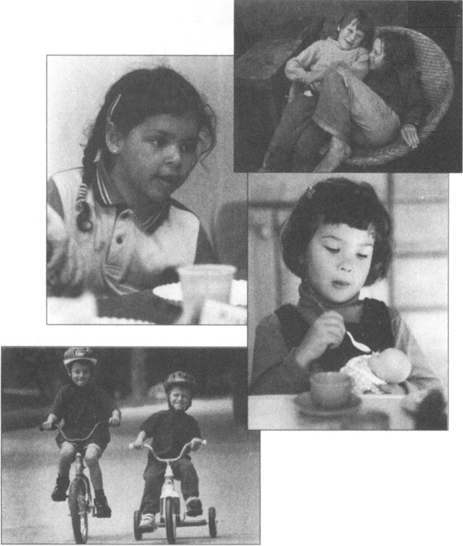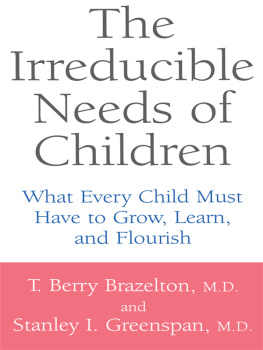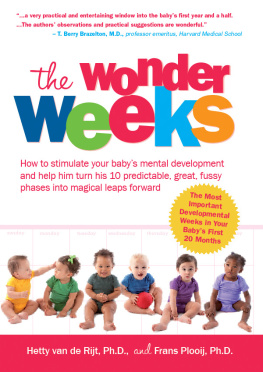

PHOTOGRAPHY BY
DOROTHY LITTELL GRECO
MARILYN NOLT
SAM OGDEN
JANICE FULLMAN


Many of the designations used by manufacturers and sellers to distinguish their products are claimed as trademarks. Where those designations appear in this book and Da Capo Press was aware of a trademark claim, the designations have been printed in initial capital letters.
Copyright 2001 by T. Berry Brazelton, M.D. and Joshua D. Sparrow, M.D.
All rights reserved. No part of this publication may be reproduced, stored in a retrieval system, or transmitted, in any form or by any means, electronic, mechanical, photocopying, recording, or otherwise, without the prior written permission of the publisher. Printed in the United States of America.
Cataloging-in-Publication Data is available from the Library of Congress
ISBN-13: 978-0-7382-1300-2
Da Capo Press is a member of the Perseus Books Group.
Find us on the World Wide Web at http://www.dacapopress.com
Da Capo Press books are available at special discounts for bulk purchases in the United States by corporations, institutions, and other organizations. For more information please contact the Special Markets Department at Perseus Books Group, 11 Cambridge Center, Cambridge, MA 02142 or email
Text design by Jeff Williams
Set in 11-point Times by Perseus Books Group
First paperback printing, September 2002
This is book is dedicated to Dr. Brazeltons grandchildren, and to Dr. Sparrows wife and children.
We would like to acknowledge the tremendous contribution of our mentor and editor, Merloyd Lawrence. She has prodded, edited, and supported us through this process.
Thanks also go to Brian Smith, Susan Ivey, and Kurt Werthmuller, who faithfully typed the manuscript.
contents


Ever since Touchpoints: Your Childs Emotional and Behavioral Development presented a map of child development during the first two years, readers have asked me to continue the map into the following years. This book extends the touchpoints concept through the crucial first-grade year. In writing this sequel, I have had the opportunity to work with a colleague, Joshua Sparrow, M.D., a child psychiatrist at Childrens Hospital in Boston, and have deepened my thinking and approach to children of these ages. It has been a rare opportunity to combine our approaches, and I hope that readers will see the benefits of our collaboration. Together we have had a great time exploring childrens development and potential for the future.

The Touchpoints Concept
Readers of the first book found comfort in the knowledge that the regressions in behavior infants display just before a burst in development are healthy and constructive. It is reassuring to view periods of regression as an opportunity to reorganize in preparation for an area of rapid development. Each new spurt in motor, cognitive, or emotional development is likely to be heralded by disorganization and regression in the childs behavior; understanding these sequences of events and predicting them has proved helpful to those caring for young children.
We call these potentially vulnerable periods touchpoints because they present an optimal time for professionals to join with parents in understanding the childs progress. Parents feel support when professionals point out the purpose of these disturbing periods; in this way touchpoints become a positive opportunity for cementing not only parent-child but also parent-physician bonds. This book addresses the predictable touchpoints in the years three, four, five, and six.
In recent years, at more than thirty sites around the country, we have been training caregivers in preventive healthcare settings and childcare centers to see these touchpoints of development as opportunities to deepen their relationships with parents. When caregivers can share distressing but hopeful moments, parents can feel more confident and enjoy their childs development. The barriers of gatekeeping, or competition between parent and supplementary caregiver, are more readily overcome when caregivers reach out to parents with an understanding of the challenges a child faces as he or she grows. Touchpoints present major opportunities for communicating about the childs temperament, the stage of development, and the special abilities or needs that help or hinder progress.
Touchpoints are based on a concept involving energy. If extra energy is needed to fuel a new, rapid development, where does it come from? For example, learning to walk is an expensive achievement; it demands all the forces the child can muster. At night, the child is up and down, crying out every three to four hours, hanging onto the crib rails. During the day, the child screams every time you dont help. These determined efforts are constant and use up the familys energy. The child is frustrated, angry, near the edge of temper tantrums night and day. But when he or she finally walks, everything changes. The child walks, walks, walks, arms wide and high, face lit up, with happiness, chortling with triumph, the goal achieved! Everyone can sleep again. Everyone relaxes and admires this great featafter the house is baby-proofed anew.
Each new step in any line of development carries such a costand such a reward. If parents can anticipate their childs touchpoints, worry about the regression and accompanying misery can be turned into excitement and appreciation of the childs efforts to move forward. If parents can share these moments with caring professionals and relatives, they will derive greater enjoyment from the milestones. Their appreciation, in turn, transforms each step into a firm base for childrens belief in themselves and in their future. Children and parents feel empowered.

Four Children
In this volume, we have imagined four children who reflect the range of temperamental differences. The concept of temperament, first proposed by Stella Chess and Alexander Thomas in 1951 and supported by subsequent decades of research, has flourished as a way of understanding each childs individual differences. Temperament affects the way each child receives, digests, and reacts to important stimuli. It is a reflection of the way the childs mind and body work to handle goals, dreams, and spurts in developmentas well as the childs response to nurturing and stressful events. Our four unique, fictional children respond to each touchpoint differently. We hope they represent a range of potential responses, and that they capture your childs style, temperament, and way of reacting to the world. Your child might be a mixture of two or three of these, or you might find that none quite captures your childs temperament. If you dont find aspects of your child here, the omission is likely to reflect our shortcoming, not your childs. But we hope that the four children we present will give you some insight into how children with great differences in temperament adapt to their worlds and learn. We also hope that each story conveys a sense of the wonder and excitement of growing up, as well as the vicissitudes and work of adjusting to each new step.
Next page









